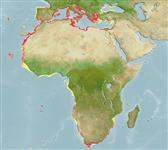>
Eupercaria/misc (Various families in series Eupercaria) >
Sparidae (Porgies)
Etymology: Sarpa: Spanish, sarpo, sapo = toad; a toad-fish (1753) (Ref. 45335).
More on author: Linnaeus.
Environment: milieu / climate zone / depth range / distribution range
Ecologia
marinhas; estuarina bentopelágico; oceanódromo (Ref. 51243); intervalo de profundidade 5 - 70 m (Ref. 3688). Subtropical; 45°N - 40°S, 26°W - 36°E
Eastern Atlantic: Bay of Biscay and Strait of Gibraltar to Sierra Leone, including Madeira, the Canary Islands, and Cape Verde; Congo to South Africa. Also present in the Mediterranean.
Length at first maturity / Tamanho / Peso / Idade
Maturity: Lm 16.5 range ? - ? cm
Max length : 51.0 cm SL macho/indeterminado; (Ref. 3397); common length : 30.0 cm SL macho/indeterminado; (Ref. 4781)
Espinhos dorsais (total) : 11 - 12; Raios dorsais moles (total) : 14 - 17; Espinhos anais: 3; Raios anais moles: 13 - 15. Black spot at the pectoral fin base. Body relatively slender with 10 golden longitudinal stripes (Ref. 35388).
Found over rocky substrates and sandy area with algal growth. Gregarious, sometimes forming sizeable schools. Young mainly carnivorous on crustaceans, adults almost exclusively herbivorous (Ref. 4781), feed on seaweeds (Ref. 36731). Protandric hermaphrodite (Ref. 4781). Tasty when fresh, but easily softens and is not much esteemed (Ref. 3198).
A monandric species (Ref. 55367). Sex change occurs at 25.0 cm TL and 3.75 years of age (Ref. 55367). Conflicting descriptions of the reproductive style of this species have been reported, including possible gonochorism (Ref. 103751). Also Ref. 28504.
Bauchot, M.-L. and J.-C. Hureau, 1990. Sparidae. p. 790-812. In J.C. Quero, J.C. Hureau, C. Karrer, A. Post and L. Saldanha (eds.) Check-list of the fishes of the eastern tropical Atlantic (CLOFETA). JNICT, Lisbon; SEI, Paris; and UNESCO, Paris. Vol. 2. (Ref. 3688)
Categoria na Lista Vermelha da IUCN (Ref. 130435)
Ameaça para o homem
Harmless
Utilização humana
Pescarias: espécies comerciais; peixe desportivo: sim; isco: occasionally
Ferramentas
Relatórios especiais
Descarregue XML
Fontes da internet
Estimates based on models
Preferred temperature (Ref.
123201): 15.3 - 24, mean 18.8 °C (based on 232 cells).
Phylogenetic diversity index (Ref.
82804): PD
50 = 1.0000 [Uniqueness, from 0.5 = low to 2.0 = high].
Bayesian length-weight: a=0.01230 (0.01109 - 0.01364), b=3.04 (3.01 - 3.07), in cm total length, based on LWR estimates for this species (Ref.
93245).
Nível Trófico (Ref.
69278): 2.0 ±0.0 se; based on diet studies.
Resiliência (Ref.
120179): Baixo, tempo mínimo de duplicação da população 4,5 - 14 anos (tmax=15; tm=2; K=0.20-.027;).
Prior r = 0.30, 95% CL = 0.20 - 0.45, Based on 4 data-limited stock assessments.
Fishing Vulnerability (Ref.
59153): Moderate vulnerability (41 of 100).
Climate Vulnerability (Ref.
125649): Low to moderate vulnerability (32 of 100).
Nutrients (Ref.
124155): Calcium = 64 [31, 129] mg/100g; Iron = 0.921 [0.492, 1.748] mg/100g; Protein = 19 [17, 21] %; Omega3 = 0.253 [0.129, 0.524] g/100g; Selenium = 28.6 [13.5, 56.9] μg/100g; VitaminA = 12.5 [3.3, 38.3] μg/100g; Zinc = 1.27 [0.88, 1.85] mg/100g (wet weight); based on
nutrient studies.
